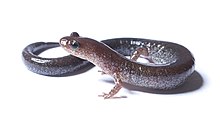Red Back Salamander
| Red-backed salamander | |
|---|---|
 |
|
| "Leadback" phase | |
| Scientific classification | |
| Kingdom: | Animalia |
| Phylum: | Chordata |
| Class: | Amphibia |
| Order: | Caudata |
| Family: | Plethodontidae |
| Genus: | Plethodon |
| Species: | P. cinereus |
| Binomial name | |
|
Plethodon cinereus (Green, 1818) |
|
| Synonyms | |
|
Salamandra cinerea Green, 1818 |
|
Salamandra cinerea Green, 1818
The red-backed (or redback) salamander (Plethodon cinereus) is a small, hardy woodland salamander. It inhabits wooded slopes in eastern North America, west to Missouri, south to North Carolina, and north from southern Quebec and the Maritime Provinces in Canada to Minnesota. It is also known as the eastern red-backed salamander or the northern red-backed salamander to distinguish it from the southern red-backed salamander (Plethodon serratus). It is one of 55 species in the genus Plethodon.
The red-backed salamander is a small (5.7 to 10.0 cm) terrestrial salamander which usually lives in forested areas under rocks, logs, bark, and other debris. It is one of the most numerous salamanders throughout its range. The red-backed salamander exhibits color polymorphism and two color variations are common: the 'red-backed' or 'red-stripe' variety has a red dorsal stripe that tapers towards the tail, and the darker variety, known as the 'lead-backed' (or simply 'lead') phase, lacks most or all of the red pigmentation. The red-backed phase is not always red, but may actually be various other colors (e.g., yellow-backed, orange-backed, white-backed, or a rare erythristic morph in which the body is completely red). Both morphs have speckled black and white bellies.
The skin of red-backed salamanders was found to contain Lysobacter gummosus, an epibiotic bacterium which produces the chemical 2,4-diacetylphloroglucinol and inhibits the growth of certain pathogenic fungi.
Antipredator behavior was found to differ between the two color phases; the lead-backed phase has a tendency to run far away from predators, whereas the red-backed phase often stays immobile and possibly exhibits aposematic coloration. Stress levels of each color phase were estimated by determining the ratio of neutrophil to lymphocyte cells in the blood, and the results suggest stress levels are higher in the lead-backed phase than in the red-backed phase. This may be a consequence of a higher predation risk experienced in the wild by the lead-backed phase, and may also mean lead-phase salamanders could be more vulnerable in captivity settings.
...
Wikipedia

